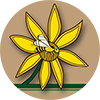Bone Lake Meadows Apiary is located in the open, rural spaces of Washington County, Minnesota. Our apiary aims towards sustainable beekeeping. Back in Mike’s Master Gardening days at the University of Minnesota, he received a colony of bees as a gift from his family. What started out as an addition to the garden for pollination became a passion in no time. Since 2001, Bone Lake Meadows Apiary has had hives in various locations along the St. Croix River Valley. As beekeepers it’s our job to set up our bees to succeed. We do this by placing our bees on organically farmed land, orchards, garden plots and CSA farms.
All of our honey is completely raw and unadulterated and filtered once to remove large chunks of wax. With this process you can both taste and see the difference. Throughout the year we have:
• Buckwheat – a dark honey with a dense earthy flavor
• Basswood – a mellow blend that captures the flavor of summer
• Clover – a light spring essence
• Goldenrod and Sunflower – a golden rich end of the summer honey.
After harvesting, we use our own beeswax to make hand-poured candles and natural lotions and lip balms. Go to our products page to learn about the scents and flavors available. Contact us or stop by one of our markets to meet your local beekeepers!
Memberships
Bone Lake Meadows Apiary is a proud member of:
Honey Bee Club of Stillwater, Minnesota
Meets the 3rd Monday of the month at 7PM at Family Means, 1875 Northwestern Ave. This is a monthly peer exchange for honeybee enthusiasts.
Cathy and Mike Mackiewicz
FAQ
What is an apiary?
n. a·pi·ar·y
A place where bees and beehives are kept, especially a place where bees are raised for their honey.
[Latin apirium, beehive, from apis, bee.]
Why does honey get cloudy or crystalize?
Most raw or unheated honey will at some point turn to sugar crystals. It is not an indicator of spoilage, impurity, age or quality. What makes honey crystallize is due to the type of flower the honey bee visited when she gathered the blossom’s nectar. The floral source determines whether the honey will turn into a solid form more quickly or not. Some honeys while raw will stay in a liquid form for quite a while. Other honeys will turn to a solid form with in a few weeks. This is due to how stable the sugar crystal is in the nectar.
If your honey crystallizes, simply place the honey jar in warm water and stir until the crystals dissolve, or place the honey container into near boiling water that has been removed from the heat.
Why is there such a difference in the color and taste of the honey?
Our hives are located up and down the St Croix River Valley. Depending on the time of year and the flowers in bloom, the nectar and pollen collected results in a different taste and color. Spring honey is usually lighter in color and fall honey is darker. Early August we will have 7 to 8 different varietals of honey – yum!
Is your honey processed?
No, the honey comes right off the hive, is extracted, strained and bottled. Our honey is straight from the hive to you!
How many times have you been stung?
Plenty, and counting. The worst sting (to date) was a bee up the nose…



